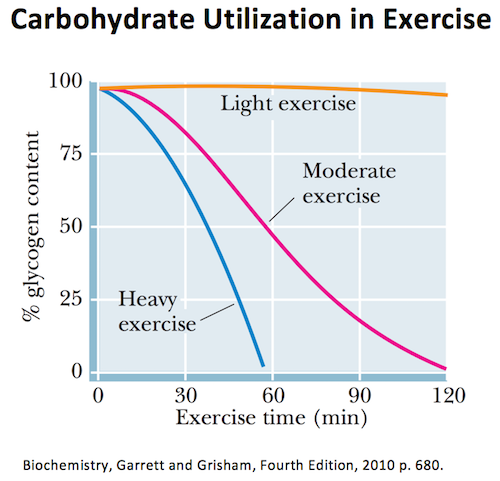The Overlooked Part of Recovery: Glycogen Replenishment
0 Comments
By Art Zemach, MD
Hard workouts and competitions can deplete your body’s energy reserves. Some signs and symptoms of energy depletion are:
- Feeling irritable or cranky after a workout
- Complaints of “heavy legs”
- Chronic colds, sick frequently
- Problems finishing speed work, or long runs
- Poor race performance
- Drowsy, poor concentration
- Late night hunger
Your body stores energy from carbohydrates as glycogen in your muscles and liver. The best time to replenish your glycogen is in the “magic hour” immediately after exercise.
The “Magic Hour”
To understand the “magic hour,” you need to know that insulin has two jobs. One job is to move glucose (the energy from carbohydrates) into cells. The other job is to shunt glucose that has already entered a cell towards energy storage, as opposed to being burned as fuel. Exercise simultaneously increases insulin sensitivity (so more energy can enter cells), and decreases insulin secretion (so more glucose will be available as fuel). The magic hour exists because while insulin suppression ceases after exercise stops, the increased insulin sensitivity persists for about an hour. So for 30 to 60 minutes after exercise, your body is in a special state, where insulin secretion is back to normal, but the body’s sensitivity to insulin is still increased. This is the best time to replenish your glycogen energy stores, and is when you want to refuel after exercise.
Slow and Fast-burning Fuels
What is the best kind of fuel to use for exercise recovery, a slow-burning fuel or a fast-burning fuel? The answer is both, but to understand that answer we need to take a look at how slow and fast-burning fuels work, and learn about the glycemic index of food. The glycemic index of a food is a measure of how quickly that food will increase your blood sugar. The low-glycemic index foods, or slow-burning fuels, like most fruits and vegetables, increase your blood sugar slowly. These are the natural foods that our bodies are expecting us to eat, and these are the best foods for us. Generally speaking, the lower the glycemic index of a food, the healthier it is for us. The high-glycemic index foods, or fast-burning fuels, like sugars, increase your blood sugar quickly. These are usually man-made or processed foods like candy, snack foods, and “fast foods.” These foods can take your blood sugar on a roller-coaster ride, by first spiking your blood sugar, to which your body over-reacts by producing too much insulin, which then drives your blood sugar low, and keeps it low. This low blood sugar, and the adrenaline and cortisol that it stimulates, can make you feel terrible, and cause a number of different health problems over time. A diet heavy in high glycemic index foods is not a healthy diet. So if slow-burning, low-glycemic index foods like fruits and vegetables are healthy, and fast-burning, high-glycemic index foods like sugars are unhealthy, why does Tailwind Rebuild, or for that matter Tailwind Endurance Fuel, contain simple sugars? The answer is exercise.
Sugars in Tailwind Endurance Fuel
Tailwind Endurance Fuel is taken continuously during long periods of exercise. When used in this way, it never spikes your blood sugar, and keeps you fueled all day long. As an added bonus, the fast-burning sugars in Tailwind can bring you back from bonking if needed, something that a low-glycemic index carbohydrate will not do very well.
Sugars in Tailwind Recovery Mix
A recovery drink needs to solve two problems. It needs a good amount of fast-burning fuel to replenish depleted glycogen. But it also needs some amount of slow-burning carbohydrates to avoid taking your blood sugar on a roller-coaster ride. That is why you will find both kinds of carbohydrates in Tailwind Rebuild.
A Few Words About Fat
From the standpoint of glycogen replenishment, you do not need fat in your recovery drink, only carbohydrate and protein. No matter how fit or lean you are, and no matter how long your endurance event is, you will not deplete your fat reserves during your workout or competition. When you finish a hard event or training, your glycogen supplies are exhausted, and your muscles need repair and rebuilding. And you need a really long nap! But you have not run out of fat. No one needs to have fats in their recovery drink to replenish their body’s supply of fat after exercise. We put some healthy fat in Tailwind Rebuild for two reasons. One is for taste. All healthy foods have a balance of carbohydrates, fats, and proteins. Your body expects this, especially after a long or stressful workout. We chose healthy, vegan coconut milk as the source for fat in Tailwind Rebuild. The second reason is to support our athletes who strive through training to teach their bodies to use fat more efficiently. Two strategies for this are low heart rate training to teach the body to obtain a greater proportion of energy from fat, and including some fat in the diet to induce enzymes that burn fat for energy.





